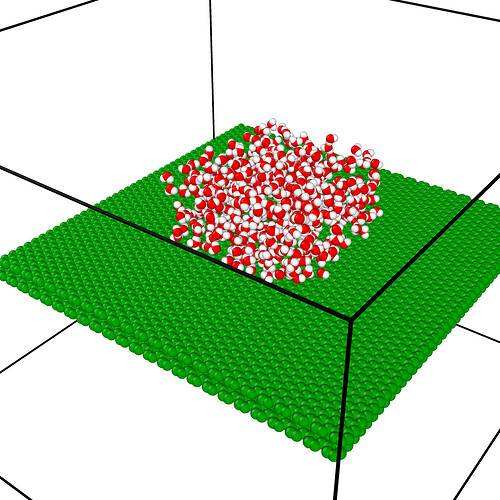I am trying to simulate a solid silicate and a water droplet on its surface I have attached the input files. The silicate and water structures are equilibrated separately. When trying to merge the structures and equilibrate the lammps running stops at the first step.
I have attached the log below
lmp -in input.lammps
Invalid MIT-MAGIC-COOKIE-1 keyLAMMPS (23 Jun 2022 - Update 2)
OMP_NUM_THREADS environment is not set. Defaulting to 1 thread. (src/comm.cpp:98)
using 1 OpenMP thread(s) per MPI task
Reading data file …
orthogonal box = (-0.58 -0.68 -0.66) to (39.32 39.22 39.24)
1 by 1 by 1 MPI processor grid
reading atoms …
6495 atoms
scanning bonds …
2 = max bonds/atom
scanning angles …
1 = max angles/atom
reading bonds …
4330 bonds
reading angles …
2165 angles
Finding 1-2 1-3 1-4 neighbors …
special bond factors lj: 0 0 0
special bond factors coul: 0 0 0
2 = max # of 1-2 neighbors
1 = max # of 1-3 neighbors
1 = max # of 1-4 neighbors
2 = max # of special neighbors
special bonds CPU = 0.001 seconds
read_data CPU = 0.019 seconds
Reading data file …
orthogonal box = (-174.67 -174.67 -4.0125) to (39.32 39.22 39.24)
1 by 1 by 1 MPI processor grid
reading atoms …
10800 atoms
reading velocities …
10800 velocities
Finding 1-2 1-3 1-4 neighbors …
special bond factors lj: 0 0 0
special bond factors coul: 0 0 0
2 = max # of 1-2 neighbors
1 = max # of 1-3 neighbors
1 = max # of 1-4 neighbors
2 = max # of special neighbors
special bonds CPU = 0.002 seconds
read_data CPU = 0.041 seconds
Reading tersoff potential file SiO.tersoff with DATE: 2010-08-16
WARNING: Converting tersoff potential in metal units to real units (src/potential_file_reader.cpp:289)
Info-Info-Info-Info-Info-Info-Info-Info-Info-Info-Info
Printed on Tue Feb 28 22:46:34 2023
Coeff status information:
Pair Coeffs:
1 1: is set
1 2: is set
1 3: is set
1 4: is set
2 2: is set
2 3: is set
2 4: is set
3 3: is set
3 4: is set
4 4: is set
Bond Coeffs:
1: is set
Angle Coeffs:
1: is set
Info-Info-Info-Info-Info-Info-Info-Info-Info-Info-Info
6495 atoms in group H2O
System init for delete_atoms …
WARNING: Using a manybody potential with bonds/angles/dihedrals and special_bond exclusions (src/pair.cpp:239)
Neighbor list info …
update every 1 steps, delay 10 steps, check yes
max neighbors/atom: 2000, page size: 100000
master list distance cutoff = 12
ghost atom cutoff = 12
binsize = 6, bins = 36 36 8
4 neighbor lists, perpetual/occasional/extra = 3 1 0
(1) command delete_atoms, occasional, copy from (4)
attributes: full, newton on
pair build: copy
stencil: none
bin: none
(2) pair lj/cut/coul/cut, perpetual, half/full from (4)
attributes: half, newton on
pair build: halffull/newton
stencil: none
bin: none
(3) pair tersoff, perpetual, skip from (4)
attributes: full, newton on
pair build: skip
stencil: none
bin: none
(4) neighbor class addition, perpetual
attributes: full, newton on
pair build: full/bin
stencil: full/bin/3d
bin: standard
Neighbor list info …
update every 1 steps, delay 10 steps, check yes
max neighbors/atom: 2000, page size: 100000
master list distance cutoff = 12
ghost atom cutoff = 12
binsize = 6, bins = 36 36 8
0 neighbor lists, perpetual/occasional/extra = 0 0 0
WARNING: Ignoring ‘compress yes’ for molecular system (src/delete_atoms.cpp:140)
Deleted 4497 atoms, new total = 12798
Deleted 2998 bonds, new total = 1332
Deleted 1499 angles, new total = 666
10800 atoms in group slab
Finding SHAKE clusters …
0 = # of size 2 clusters
0 = # of size 3 clusters
0 = # of size 4 clusters
666 = # of frozen angles
find clusters CPU = 0.001 seconds
WARNING: Using a manybody potential with bonds/angles/dihedrals and special_bond exclusions (src/pair.cpp:239)
Neighbor list info …
update every 1 steps, delay 10 steps, check yes
max neighbors/atom: 2000, page size: 100000
master list distance cutoff = 12
ghost atom cutoff = 12
binsize = 6, bins = 36 36 8
3 neighbor lists, perpetual/occasional/extra = 3 0 0
(1) pair lj/cut/coul/cut, perpetual, half/full from (3)
attributes: half, newton on
pair build: halffull/newton
stencil: none
bin: none
(2) pair tersoff, perpetual, skip from (3)
attributes: full, newton on
pair build: skip
stencil: none
bin: none
(3) neighbor class addition, perpetual
attributes: full, newton on
pair build: full/bin
stencil: full/bin/3d
bin: standard
Setting up Verlet run …
Unit style : real
Current step : 0
Time step : 1
how to solve it. the running stops here. I have attached the input script and the data files.
data.final_sio2 (1.5 MB)
data.water (471.4 KB)
input.lammps (1.5 KB)
SiO.tersoff (1.9 KB)
